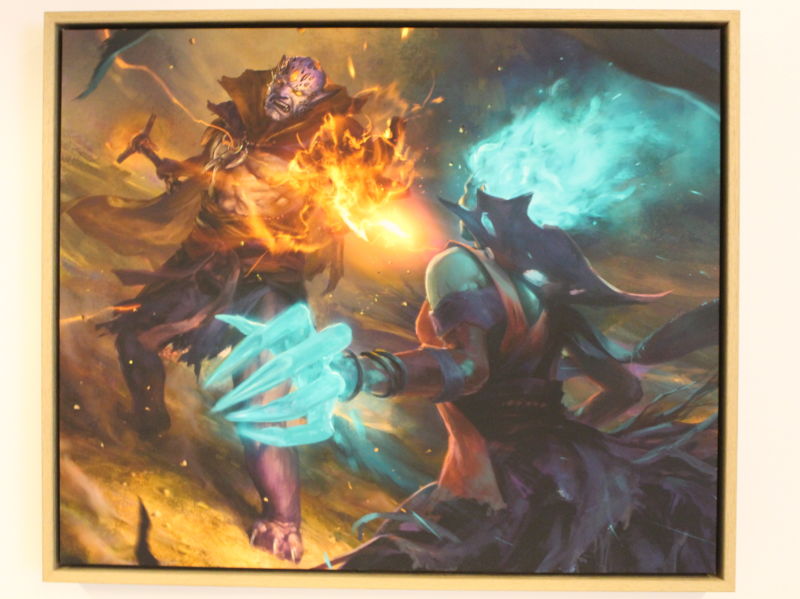
Valve Software's first brand-new video game since 2013, the digital card-dueling game Artifact, finally has a release date: November 28.
This is the first Valve game since Counter-Strike: Global Offensive to launch with a fixed release price as opposed to the free-to-play model enjoyed by Valve games like Dota 2 and Team Fortress 2. Anyone who wants to play Artifact will need to buy the game's base model at $19.99, which will be available on all Steam platforms—meaning Windows, MacOS, and Linux.
What exactly does $19.99 get you? The game maker didn't answer this in its press release, so we reached out to Valve's Doug Lombardi, who broke down the exact package included in that cost: two pre-made "base" decks of 54 cards each ("5 heroes, 9 items, and 40 other cards") and 10 sealed packs of cards, which each include 12 random cards, one of which is guaranteed to be "rare." Additional 12-card packs will be sold directly by Valve at $2 a pop at launch.
One exception to that upfront cost will come at this month's PAX West. Anyone who waits in line and plays Valve's first public hands-on demo of the game will receive two free keys to unlock the game's base model when it launches on Steam later this year.
The game will also launch on iOS and Android in "2019," but details about that version's cost, or whether players will be able to take their paid Steam version to their favorite smartphone device, were not disclosed today.
Modes, economies, and questions
Artifact, as we discovered in our lengthy, world-premiere hands-on earlier this year, cranks up the mechanics of the popular card game Magic: The Gathering by having players manage three "lanes" of cards in one-on-one battles. While this three-lane system, and the game's collection of heroes, are wholesale borrowed from Valve's Dota 2, the game's design was spearheaded by the guy who created Magic in the '90s, Richard Garfield—and he insisted to Ars that the design was not bent or molded just to fit into the Dota 2 universe.
The game's first 280 playing cards include "heroes," attacks, spells, items, and other Magic-like options that can be shuffled into a given deck. (You can have as many cards in a deck as you'd like.) Unlike other digital card games, future changes to Artifact will be a lot more Magic-like. New cards will be introduced to the game as digital purchases, likely in "sealed packs" directly from Valve. Additionally, certain modes may revolve around card packs, according to Valve co-founder Gabe Newell; he suggested in March that "draft pack" and "sealed pack" modes may eventually ship with the game.-
At the most zoomed-out level, every Artifact 1.0 match begins like this: with three lanes of combat, across which you will arrange five heroes in a mission to destroy towers. Sure sounds a lot like how Dota 2 works, doesn't it? (Not shown here: the "flop" of your creeps that are randomly added and arranged between every round.)
-
Now we're zoomed in on a lane. Based on the attack, armor, and health stats on the board, the game will show you how the round will end should no other cards be played or mana/gold be spent. The bottom player has one unblocked hero, who will directly attack the top player's defense tower. Both players still have all three points of mana for this lane, which they can spend on any three-or-less card in their hand that matches the color of any hero(es) in the same lane. The top player is out of luck if they don't have any black cards in that value. Tap the "pass gong" in the bottom-right corner if you would rather not play any of your cards.
-
This flashy animation is a result of Luna's incredible hero-specific ability "Eclipse."
-
Sometimes, due to sacrifices in previous rounds, you may wind up with zero creeps or heroes in a lane, at which point your opponent can wail on your tower. (Much like when things go bad in a Dota 2 match.) But again, like that game, sometimes letting one tower go is worth it in terms of swinging your momentum to the two other lanes, as you only need to drop two towers to win. (When you destroy a tower, by the way, it comes back with 80 HP instead of the standard 40 HP. Your foe can just hang around and re-destroy that boosted "ancient tower" to count as a second downed tower and win a match.)
-
The top row represents equippable items that you can add to your heroes through the course of the game, and this zoom shows that the equipped sword and ring boost this character's attack and health stats.
Those future cards, and cards in the starter set, will be sellable to other players as purchases over the Steam Marketplace (from which Valve will likely take a cut, as it already does with other paid-item transactions between users). Because the base $20 package includes a number of "sealed" card packs, these may very well introduce duplicates into a new player's starting card set, which players can then take to the Steam Marketplace to sell or trade.
Garfield and friends seem intent on leveraging the concepts behind the real-world Magic marketplace—meaning a game that is regularly updated by introducing new, paid cards as opposed to requiring expansions that may render older cards moot. Whether digital-card fans will prefer this over the expansion-driven economy behind Blizzard's Hearthstone remains to be seen.
Listing image by Sam Machkovech
reader comments
130